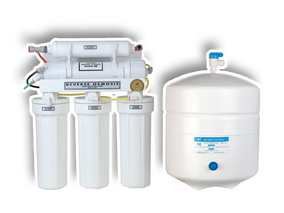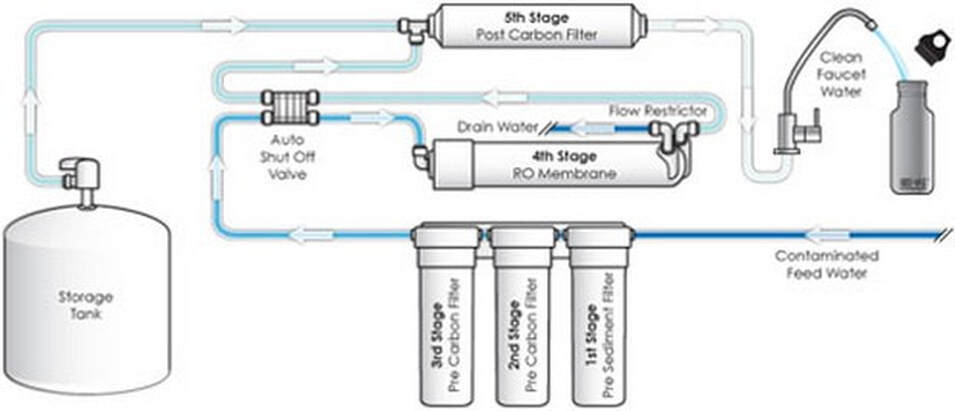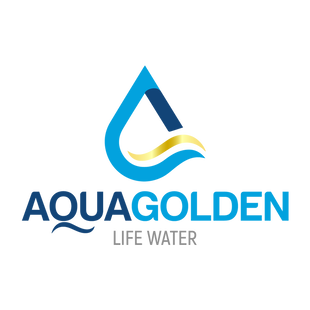The popularity of water treated by Reverse osmosis has grown steadily since this water purification system was introduced.
 RO 5 Stages (filters)
RO 5 Stages (filters)
Reverse osmosis systems have many advantages.
They are respectful of the environment since they do not produce or use chemical or harmful products during their process. Also, Reverse Osmosis systems require a minimal amount of energy. The taste of purified water is another distinct advantage. Reverse Osmosis removes dissolved minerals and other contaminants that make water smell unpleasant, taste bad, or have unusual colors.
Reverse Osmosis systems are compact, taking up less space than other water treatment systems.
Most Reverse Osmosis systems are fully automated and are designed for automatic start-up and shutdown via locks. Therefore, Reverse Osmosis plants generally require little labor.
Another advantage is that due to its modular design, maintenance is easy.
Scheduled maintenance can be performed without shutting down the entire plant.
Its modular design also makes plant expansion an easy option.
Not to mention the health benefits, the Reverse Osmosis process removes sodium molecules from the water, large sodium molecules cannot pass through the membranes of the reverse osmosis filter system, so drinking water from Reverse Osmosis provides benefits to people with high blood pressure or suffering from liver disease.
Treated water can also be very beneficial for cancer patients, especially during radiotherapy or chemotherapy, as the immune system is weakened during this process. Untreated water can contain harmful microorganisms and tiny germs that can cause infection.
They are respectful of the environment since they do not produce or use chemical or harmful products during their process. Also, Reverse Osmosis systems require a minimal amount of energy. The taste of purified water is another distinct advantage. Reverse Osmosis removes dissolved minerals and other contaminants that make water smell unpleasant, taste bad, or have unusual colors.
Reverse Osmosis systems are compact, taking up less space than other water treatment systems.
Most Reverse Osmosis systems are fully automated and are designed for automatic start-up and shutdown via locks. Therefore, Reverse Osmosis plants generally require little labor.
Another advantage is that due to its modular design, maintenance is easy.
Scheduled maintenance can be performed without shutting down the entire plant.
Its modular design also makes plant expansion an easy option.
Not to mention the health benefits, the Reverse Osmosis process removes sodium molecules from the water, large sodium molecules cannot pass through the membranes of the reverse osmosis filter system, so drinking water from Reverse Osmosis provides benefits to people with high blood pressure or suffering from liver disease.
Treated water can also be very beneficial for cancer patients, especially during radiotherapy or chemotherapy, as the immune system is weakened during this process. Untreated water can contain harmful microorganisms and tiny germs that can cause infection.
The 5 stage RO system:
-
First Filter
-
Second Filter
-
Third Filter
-
Fourth Filter
-
Fifth Filter
<
>
A 5-micron filter removes sediment including dirt, sand, rust, grit, and other suspended matter from the water. This protects the rest of the filtration stages and equipment from damage and clogging due to buildup of sediment.
A carbon block filter removes chlorine, chemicals, and objectionable tastes and odors from the water. This filter also protects the membrane from exposure to chlorine, which would irreparably damage the membrane.
A second carbon block filter is an extra layer of filtration to ensure the removal of any remaining chlorine, chemicals, and flavors – ensuring great tasting water and maximum membrane protection.
Passes through the membrane where it removes 99% of all contaminants (good and bad minerals), including arsenic, barium, cadmium, chromium (hexavalent), chromium (trivalent), copper, turbidity, fluoride, lead, radium 226/228, and selenium while washing the rejected contaminants down the drain.
The coconut shell carbon filter gives one last stage of filtration to perfect the flavor of the water. The water is filtered as it flows from the storage tank, directly before being dispensed from the faucet.





